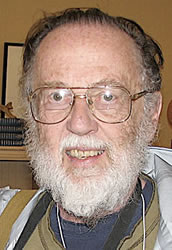

|

|
IN MEMORIAM
John Robert Stallings Jr.
Professor of Mathematics, Emeritus
UC Berkeley
1935 – 2008
Born in Morrilton, Arkansas, on 22 July 1935, John Robert Stallings Jr. graduated from the University of Arkansas in 1956, and finished his doctorate in mathematics at Princeton University in 1959. After a fellowship at Oxford University and a stint teaching at Princeton, he became a professor at the University of California, Berkeley, in 1967.
Stallings received many honors. He was awarded the Frank Nelson Cole Prize in Algebra by the American Mathematical Society in 1970, a prize given every five years for the best work in that five-year period. He was a Sloan Research Fellow in 1962-1965 and a Miller Institute Professor in 1972-1973. He delivered an invited address at the International Congress of Mathematicians in Nice in 1970. A conference, “Geometric and Topological Aspects of Group Theory,” was held at the Mathematical Sciences Research Institute in honor of his 65th birthday, and a special issue of the journal Geometriae Dedicata was dedicated to him.
Most of John's mathematical contributions are in the areas of geometric group theory and low-dimensional topology (particularly the topology of 3-manifolds) and on the interplay between these two areas.
He first achieved fame with his 1960 proof of the Poincaré Conjecture in dimensions n > 6. (His proof was obtained independently of, and shortly after, the different proof of Steven Smale, who established the same result for all n > 4.)
The original version of the Poincaré Conjecture was for dimension n = 3, and was one of the most famous problems in mathematics for over a century, until it was solved in 2006. A few years after his positive result for n > 6, Stallings published a paper, entitled “How Not to Prove the Poincaré Conjecture,” which began with a humorous admission: “I have committed the sin of falsely proving Poincaré's Conjecture. But that was in another country; and besides, until now, no one has known about it.” The paper went on to give a group-theoretic reformulation of the famous conjecture, and, despite its ironic title, it informed much of the subsequent research on the algebraic aspects of the subject.
The paper explained the errors in his incorrect proof for n = 3 “in hope of deterring others from making similar mistakes,” and ended on a musing note: “I was unable to find flaws in my ‘proof’ for quite a while, even though the error is very obvious. It was a psychological problem, a blindness, an excitement, an inhibition of reasoning by an underlying fear of being wrong. Techniques leading to the abandonment of such inhibitions should be cultivated by every honest mathematician.”
Using “engulfing” methods similar to those in his proof of the Poincaré Conjecture for n > 6, John showed in 1962 that ordinary Euclidean n-dimensional space has a unique piecewise linear (hence also smooth) structure if n is not equal to 4. This took on added significance when, as a consequence of the work of Michael Freedman and Simon Donaldson in 1982, it was shown that 4-dimensional space has exotic smooth structures, in fact uncountably many such.
John's most famous theorem in group theory is an algebraic characterization of groups with more than one end (that is, with more than one “connected component at infinity”), now known as Stallings' theorem about ends of groups. It states that a finitely generated group G has more than one end if and only if G admits a nontrivial splitting as an amalgamated free product or as an HNN-extension over a finite group.
John was interested in languages. In 1968 he wrote an article, “Sur un generalisation del notion de producto libere amalgamate de gruppos,” in the artificial language Interlingua. He apparently never published it in that form, but it appears in English, almost word for word, in his 1971 monograph Group Theory and Three-Dimensional Manifolds, as section 3.A, “A Generalization of the Notion of Amalgamated Free Product of Groups.”
John had 22 Ph.D. students and, after retiring in 1994, continued to advise students through 2005. He was much admired, not just for his mathematics, but for being true to his beliefs, always taking an independent and original path. He had a light, irreverent, self-effacing sense of humor. His Ph.D. students, in messages read at his memorial service, wrote fondly of his generosity, his love of the outdoors, his dislike of rules, and the many things they learned from John in addition to mathematics.
John died of cancer at age 73 on 24 November 2008. He is survived by lifelong companion Marjorie Mulcahy and his nephews, Sandy Wilbourn and Chris Wilbourn.
Robion Kirby 2009
George M. Bergman